
Genetic (O-level biology)

Genetics (O-level)
This is a branch of biology that tries to explain the cause of similarities and differences between parents and their offsprings. The first quantitative experiments on hereditary of any significance were carried out in the middle of the nineteenth century by Gregor Mendel on the garden peas
Specific objectives
The learner should be able to
- Explain the concept of inheritance
- Define genetics terms
- Explain the inheritance of trains using the monohybrid and dihybrid crosses.
- Discuss the challenges of inheritable disorders
Terminologies.
- Agene
This is the basic unit of hereditary and occupies a discrete position on the chromosomes. The gene controls the production of enzymes which in turn determines the process that goes on in a cell and eventually in the organ and the entire organism. In sexually reproducing organisms, genes occur in pairs, where each member of a pair is contributed by the female and male parents.
- Alleles (Allelomorphs)
This is one of the pair of a gene that occupies the same locus (position). Alleles are genes that are responsible for the production of contrasting characteristics such as tallness and shortness in plants and animals.
- Genotype
This is the genetical constitution of an organism i.e. the particular set alleles, leading to observable characteristics
- Phenotype
This is the physical characteristic of an organism determined by the genotype and the environment.
Monohybrid inheritance
This an inheritance that deals with a single pair of contrasting characteristics such as Tallness and shortness when concerned with the height of peas.
In his investigation of a single pair of contrasting characteristics, Mendel observed that in the first filial (F1) generation one of the characters never appeared only to appear in the second filial (F2) generation in small proportion compared to the one that appeared in the first filial (F1) generation.
For example; he crossed peas with long internode, with peas of the short internode. He observed that in the F1 generation, all plants had tall internodes. When selfed to produce F2, the peas with short internodes, then appeared in small proportions.

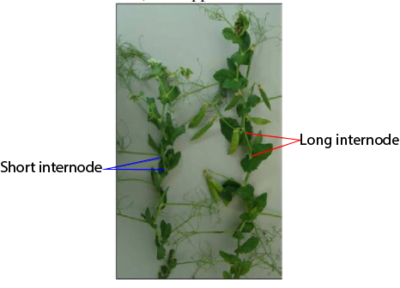
The result of these crosses can be illustrated as follows,
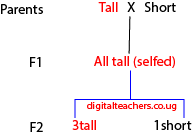
It was concluded from the results that inheritance is a process in which discrete structure or particle (genes) which may or may not show themselves in the outward appearance of the organism are transmitted from parent to offspring.
The evidence of the existence of inheritable particles is got from the observation that they can be combined in one generation but separate in the next, as in witness by the recovery of the short form in F2 generation despite its absence in the F1 generation,
The characteristic that shows in F1 generation (tallness in this case) is described as being dominant and while that which masked F1 generation (shortness) is said to be recessive.
Genes and their transmission
Genes normally occur in pair each of which is obtained from each parent. The cross of a tall plant and short plant is shown diagrammatically by the two methods below.
The allele for tallness (dominant) character is represented by a capital letter T while the allele for shortness (recessive character) is represented by small letter t. It is assumed that each parent plant contains a pair of identical alleles; TT in case of tall plant and tt in case of short plant.
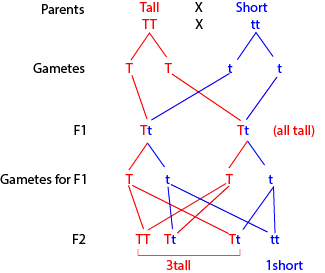
Pannet square to show fusion of F1 gametes
½ T |
½ t | |
| ½ T | ¼ TT | ¼ Tt |
| ½ t | ¼ Tt | ¼ tt |
In terms of probability, there are 3 chances out of four for a tall plant to appear in F2 generation; and one chance of four for a short plant to appear.
Mendel’s first law of segregation states that an organism’s characteristics are controlled by two genes (alleles) and only one can be carried by in a gamete.
Mendel’s second law of Independent Assortment:
During the formation of gametes, alleles in a pair may combine with another allele from another pair randomly.
Breeding True
Phenotypically TT and Tt are the same i.e. Tall. When an organism contains identical alleles like TT and tt is said to be homozygous and with dissimilar allele is heterozygous.
Since the homozygous (TT) and heterozygous (Tt) peas are both tall there is no way we can distinguish between the two genotypes from their external appearance.
One way of establishing whether a given tall plant is homozygous or heterozygous is to self-pollinate it. If the resultant offsprings are all tall, we can conclude that the parent has the genotype TT.
If, however, we get a mixture of Tall and short plants; the parent plant must have the genotype Tt
The point is that when an organism that is homozygous at a particular locus is self- fertilized it produce offsprings all of which are identical with parent. Exactly the same results occur if organisms crossed with another organism that is homozygous is said to breed true, The organism is said to belong to a pure line for the characteristics in question.
Test crosses
This is the crossing of an individual having a homozygous recessive genotype with an individual showing a dormant trait to determine whether that individual is homozygous or heterozygous for the trait.
The homozygous individual produces all offspring having dominant traits while a heterozygous individual produces a mixture of offspring with dominant and recessive traits.
Back cross
This is a cross between hybrids in F1 generation with one of the parents or an organism genetically equivalent to the parents. Backcrossing is mainly aimed at increasing the genetic contribution of one particular parent to the offsprings.
Monohybrid inheritance human
A number of human conditions are known to be associated with a single pair of alleles that are inherited in Mendelian fashion.
- Albinism
This is a condition in human beings where the individual fails to produce skin pigments called melanin.
Albinos have;
- Light skin
- White hair
- Pink eyes
- They are sensitive to bright light

The allele for albinism is caused by recessive [a] and so only exerts its effect in the homozygous state [aa]. The allele for melanin production [A] is dominant.
Suppose a couple each with normal pigmentation have an albino child. For this to happen the child must have [aa]. Therefore, unless for rare mutation, the parents must both heterozygous [Aa] so each produces A and gametes in about equal number. Therefore, randomly to produce three types of genotype AA, Aa, aa.

2. Congenital diseases such as cystic fibrosis in which the connective tissue develops in glands of the body.
3. Chondrodystrophic dwarfs are characterized by shortened and deformed legs and arms. It is caused by a dominant gene and hence affect in the homozygous and heterozygous state
CO-DOMINANCE
This is a condition where genes determining a particular character all show up such that the phenotype of the offspring is a mixture of that of the parents. It mainly occurs in animals.
Co-dominance is wherein the heterozygous state neither allele is completely dominant over the other i.e. the 2 alleles are co-dominant. This results in the phenotype intermediate between the parent’s appearances. The alleles for each trait are represented with different capital letters.
Questions:
- In animals, the genes for fur color are co-dominant. What will be the offsprings when a red bull is crossed with a white cow?
Solution:
Let R represent the allele for red bull
Let W represent the allele for white cow

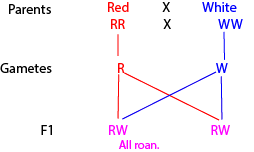
F1 generation are all roan
- What would be the off springs in the 2nd generation?

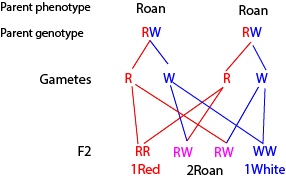
F2 generation: 1 red: 2 roan: 1 white
.
INCOMPLETE DOMINANCE
This is a condition in the heterozygous where neither of the alleles is dominant over the other and the phenotype of the offspring is an intermediate between that of the parents. It mainly occurs in plants.
For example, consider petal colour in flowers: when a red flowered plant is crossed with a white flowered plant, the offspring produced are all pink coloured petal flowers.
Example:
Let R represent the allele for red petal colour.
Let W represent the allele for white flowers
Then Selfing F1 (Cross between offspring in F1)
.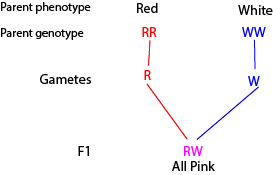

F2 Phenotypic ratio: 1 red: 2 pink: 1 white. (1:2:1)
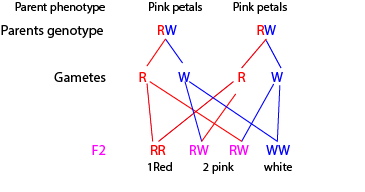
Sex determination.
The medium size chromosome in drosophila melanogaster determine the individual’s sex for which reason they are called the sex chromosome. In the female the two sex-chromosome, both rod-shaped in appearance, are identical and are known as X-chromosomes. In the male, however the two sex-chromosome differ from each other one is rod-shaped X-chromosome, the other is hook-shaped and is called Y-chromosome.
The sex chromosomes are exception to the rule that homologous chromosomes are identical in appearance. Being different they are described as heterosomes; All the other chromosomes, which are identical in appearance, are called autosomes.
Despite this difference, the sex chromosomes are transmitted in a normal mendelian manner as shown below.
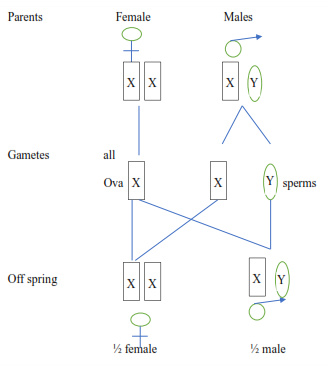
Generally, a female produces only one kind of gamete as the chromosomes are concerned; all her eggs contain an X chromosome. For this reason, in human, and many other species, the female is said to be homogametic (same gametes). A male on the other produces two kinds of gametes as far as chromosome are concerned: half of the sperm contains a Y chromosome, the other half an X. The male is therefore heterogametic (different gametes) on fusing randomly, approximately half the zygotes receive two X chromosomes and develop into female, the rest receive Y chromosomes and give rise to males. In some insects, females are XX and male XO
Sex linkage
Sex-linked characters are those whose genes that are carried on sex chromosomes usually X-chromosomes and is inherited along with sex for examples:
- red-green color blindness the decreased ability to see color or differences in color. Simple tasks such as selecting ripe fruit, choosing clothing, and reading traffic lights can be more challenging. People with total color blindness (achromatopsia) may also have decreased visual acuity and be uncomfortable in bright environment.
- hemophilia
Symptoms of hemophilia are
- Unexplained and excessive bleeding from cuts or injuries, or after surgery or dental work
- Many large or deep bruises
- Unusual bleeding after vaccinations
- Pain, swelling or tightness in your joints
- Blood in your urine or stool
- eye color in drosophila
Transmission
Hemophilia can be represented as follow
- A female hemophilic and normal man
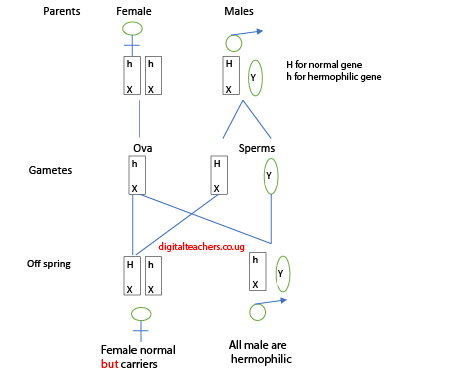
- Female normal X male hemophilic
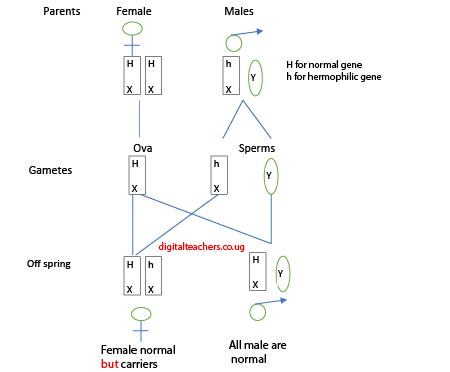
THE Y-CHROMOSOME.
1.If a sex-linked trait is associated exclusively with Y-chromosome, it is expected to show up exclusively in males. In general, most Y-chromosome are empty. However, the ‘porcupine’ man is said to have transmitted hard and spine skin exclusively to his male children.
2. The hair pinna or ear is a characteristic common in India and it is transmitted to male offsprings only.
Sex limited characters
These are characters that that show up exclusively in one sex only e.g. ovary in female
Note: A sex – limited character is one which is controlled by a gene located on any chromosome but expresses itself in only one of the two sexes.
Multiple alleles
Multiple alleles are two or more alternative forms of a gene controlling a particular characteristic, of which any two may occupy the same gene loci on homologous chromosomes.
An example of such multiple alleles is provided by the alleles controlling the ABO blood group system in humans. The ABO system is controlled by three alleles generally referred to as IA, IB, and IO.
The IA allele is responsible for production of type A antigens in the person’s red blood cells, and the IB allele for type B antigen. The I0 produces neither antigen.
But only two of the three alleles can be present at any one time, an individual may thus, possess any of the following six genotype; IAIA, IAI0, IBIB, IBIO, IAIB, and IOIO.
IA and IB show equal dominance with respect to one another [i.e. they are codominant] but each is dominant to IO thus;
- A person belongs to blood group A has genotype IAIA or IAI0
- A person belongs to blood group B has genotype IBIB or IBIO
- A person belong to blood group AB has genotype IAIB
- A person belongs to blood group O has genotype IOIO
The fact that there more than two alleles responsible for determining the blood group makes no difference to their transmission, which takes place in a normal mendelian fashion.
Thus, a child whose parents are both blood group O must be group O. However, a parent with blood A or B, the child may have any of the blood groups has shown below.
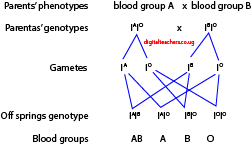
Blood transfusion
This the giving of blood to a patient who has lost a lot of blood due to accidents or who lacks lack enough blood due to other causes. The person who gives blood is called a donor while the person who receives blood is the recipient.
A doctor needs to careful to match the blood of the donor and recipient because when some blood is mixed, red blood cell sticks together of agglutinate, which may be fetal. The blood that does not agglutinate when mixed are said to be compatible.
Agglutination is caused by the presence or absence of two antigens called A and B in the red blood cells, and antibodies, called anti-A and anti-B in the sera.
Everybody can be placed in one of the four groups according to the antigen and antibodies their blood contains shown in the table below
| Person’s blood group | Antigen on the red blood cells | Antibodies in the sera |
| A B AB O | A B A +B none | Anti-B Anti-A None Anti-A + Anti-B |
The shows compatible transfusion
| Recipient blood group | Donor blood group |
| Group A Group B Group AB Group O | Group A or O Group B or O Group A, B, AB or O Group O |
Variation, in biology
This is any difference between cells, individual organisms, or groups of organisms of any species caused either by genetic differences (genotypic variation) or by the effect of environmental factors on the expression of the genetic potentials (phenotypic variation).
Importance of variation
Genetic variation is an important force in evolution as it allows natural selection to increase or decrease frequency of alleles already in the population. …
The higher the genetic variations, the higher the chances of survival of a population in a changing environment.
Categories of variation
There are two types of genetic variations.
(i) Continuous variations.
These are variations that show a gradual change in individuals without a clear-cut division between the two extremes. It results into formation of intermediates. Such variations include height, intelligence, skin colour, yield in plants, etc. In such variations, organisms are usually very many around the mean/average point.

(ii) Discontinuous variation.
This is a variation, which shows a clear-cut difference between the two extremes without intermediates. This results into expression of only two phenotypes. Examples of discontinuous variations include, tongue rolling, blood groups, sex, etc.
Causes of variation
Some variations are inherited and are called inherited variations while others are occupied as a result of the environment hence called environmental variations.
Examples of inherited variations are blood groups, eye colour, albinism, hair, etc.
Examples of environmental variations are knowledge, etc.
Environmental factors that cause variations
- Diet
- Pathogens
- Altitude
- Light
Factors that cause inherited variations
- Mutation
A Mutation occurs when a DNA gene is damaged or changed in such a way as to alter the genetic message carried by that gene.
A Mutagen is an agent of substance that can bring about a permanent alteration to the physical composition of a DNA gene such that the genetic message is changed.
- Crossing over
- Fertilization
For revision question and answers download PDF

no thanks
Really helpful work
It indeed does take quite some time to find great information like this. Thank you very much.
Its really great work, thanks a lot for this move
Thankyou for good notes am proud of you
Thanks-a-mundo for the blog post.Really looking forward to read more. Keep writing.
I’m constantly learning from your posts. Car & Motorbike
Thanks for being so informative. Barcelona News
Explore premium opportunities in healthcare education through MBBS Direct Admission in Punjab.
Learn how MBBS Direct Admission in Haryana helps aspiring medical students.
Join players worldwide in the action-packed Raja Luck Game.